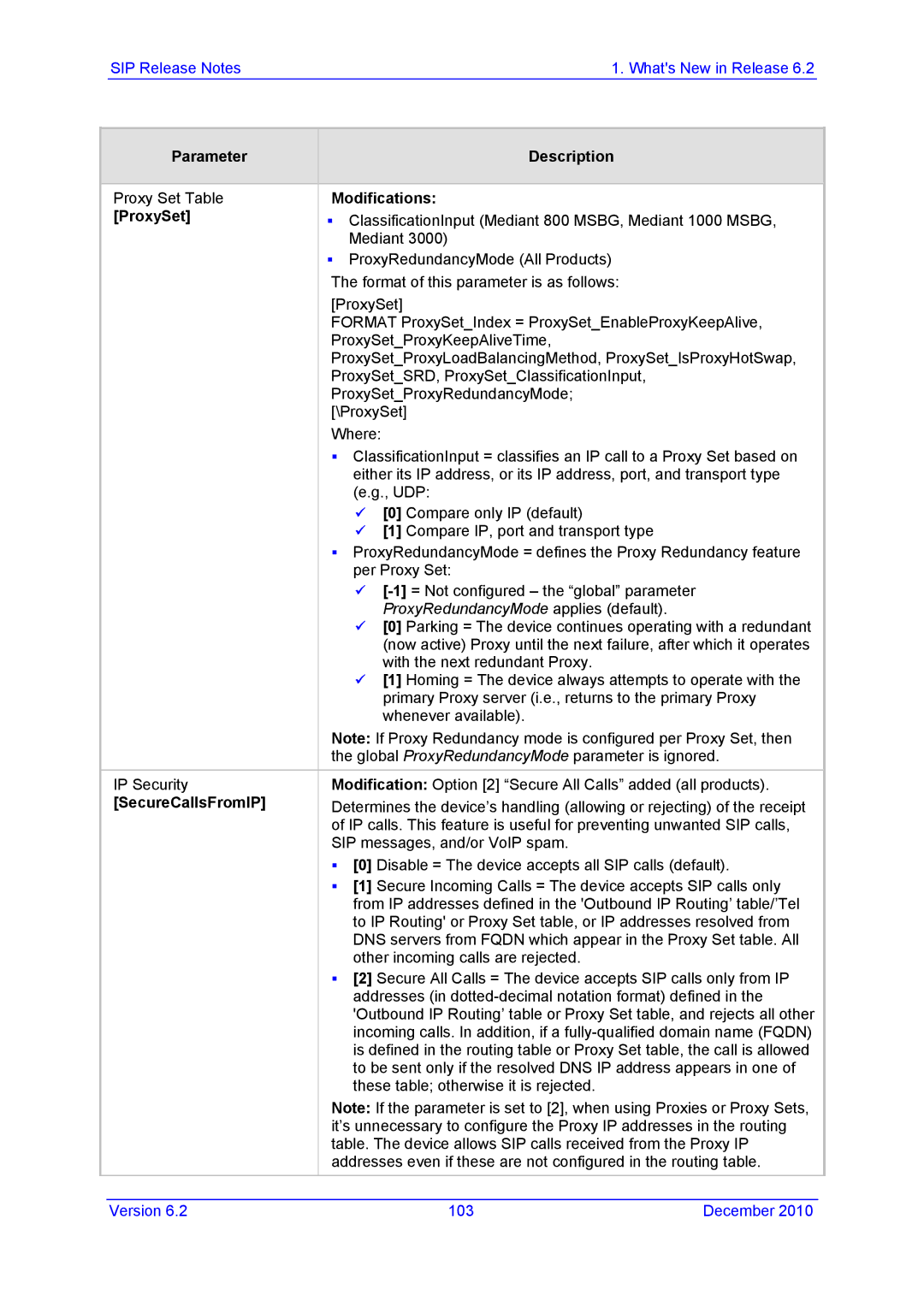SIP Release Notes | 1. What's New in Release 6.2 |
| Parameter | Description |
|
|
|
|
|
|
|
| Proxy Set Table | Modifications: |
|
|
| [ProxySet] | ClassificationInput (Mediant 800 MSBG, Mediant 1000 MSBG, |
| |
|
| Mediant 3000) |
|
|
|
| ProxyRedundancyMode (All Products) |
|
|
|
| The format of this parameter is as follows: |
|
|
|
| [ProxySet] |
|
|
|
| FORMAT ProxySet_Index = ProxySet_EnableProxyKeepAlive, |
| |
|
| ProxySet_ProxyKeepAliveTime, |
|
|
|
| ProxySet_ProxyLoadBalancingMethod, ProxySet_IsProxyHotSwap, |
| |
|
| ProxySet_SRD, ProxySet_ClassificationInput, |
|
|
|
| ProxySet_ProxyRedundancyMode; |
|
|
|
| [\ProxySet] |
|
|
|
| Where: |
|
|
|
| ClassificationInput = classifies an IP call to a Proxy Set based on |
| |
|
| either its IP address, or its IP address, port, and transport type |
| |
|
| (e.g., UDP: |
|
|
|
| [0] Compare only IP (default) |
|
|
|
| [1] Compare IP, port and transport type |
|
|
|
| ProxyRedundancyMode = defines the Proxy Redundancy feature |
| |
|
| per Proxy Set: |
|
|
|
|
|
| |
|
| ProxyRedundancyMode applies (default). |
|
|
|
| [0] Parking = The device continues operating with a redundant |
| |
|
| (now active) Proxy until the next failure, after which it operates |
| |
|
| with the next redundant Proxy. |
|
|
|
| [1] Homing = The device always attempts to operate with the |
| |
|
| primary Proxy server (i.e., returns to the primary Proxy |
| |
|
| whenever available). |
|
|
|
| Note: If Proxy Redundancy mode is configured per Proxy Set, then |
| |
|
| the global ProxyRedundancyMode parameter is ignored. |
| |
| IP Security | Modification: Option [2] “Secure All Calls” added (all products). |
| |
| [SecureCallsFromIP] | Determines the device’s handling (allowing or rejecting) of the receipt |
| |
|
| of IP calls. This feature is useful for preventing unwanted SIP calls, |
| |
|
| SIP messages, and/or VoIP spam. |
|
|
|
| [0] Disable = The device accepts all SIP calls (default). |
| |
|
| [1] Secure Incoming Calls = The device accepts SIP calls only |
| |
|
| from IP addresses defined in the 'Outbound IP Routing’ table/’Tel |
| |
|
| to IP Routing' or Proxy Set table, or IP addresses resolved from |
| |
|
| DNS servers from FQDN which appear in the Proxy Set table. All |
| |
|
| other incoming calls are rejected. |
|
|
|
| [2] Secure All Calls = The device accepts SIP calls only from IP |
| |
|
| addresses (in |
| |
|
| 'Outbound IP Routing’ table or Proxy Set table, and rejects all other |
| |
|
| incoming calls. In addition, if a |
| |
|
| is defined in the routing table or Proxy Set table, the call is allowed |
| |
|
| to be sent only if the resolved DNS IP address appears in one of |
| |
|
| these table; otherwise it is rejected. |
|
|
|
| Note: If the parameter is set to [2], when using Proxies or Proxy Sets, |
| |
|
| it’s unnecessary to configure the Proxy IP addresses in the routing |
| |
|
| table. The device allows SIP calls received from the Proxy IP |
| |
|
| addresses even if these are not configured in the routing table. |
| |
|
|
|
|
|
|
|
|
|
|
| Version 6.2 | 103 | December 2010 |
|
